What does a techie need to know about the humanities?

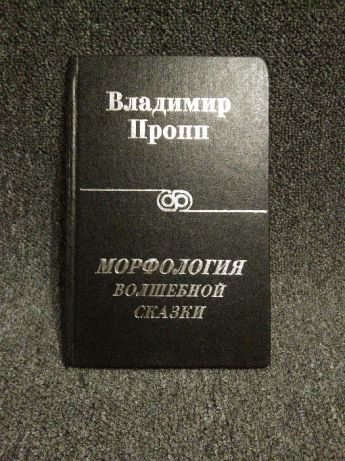

To begin with, the division into physicists and lyricists came up in the 60s for laughter, such as Westerners and Slavophiles, or patriots and liberals, Spartak or Dynamo - the classic “two-party system” clearly shown in the South Park series about an enema and a sandwich. Even the ancient Romans called this principle "divide and conquer."
As a result, different teams were given different books, but others said “it’s boring, you don’t understand, and NO NEED to understand”, but it’s easy to understand, the main thing is to look through other glasses, change the paradigm. After all, none of the paradigms are true, but binocular vision makes life much easier. And here, they gave people different points, one plus, the other minus, the humanities of gears in the clock not to consider, and for techies after 200 meters the whole nature is an abstraction.
But here, friends, is the golden key that opens the worlds - three books with well-structured info on the humanities. These three will definitely be enough for a techie to understand the basic humanitarian laws and start to see how it works at the level of mechanics.
1. Million Dollar Million Dollar History

Hollywood guru rowing with a shovel at screenwriting advice. A book counter is an extremely concrete cookbook of the script writer. Here the structure of the film is described technically and professionally, as it should be so that the film would like the audience. In fact, there are no new views or revelations in it, this is not McLuhan, this is a reference book, American behaviorism. The cookbook is so cool. No verses about the delicate taste of Julien, no, on the contrary - cut the mushrooms into slices 0.3-0.5cm, add 100 ml of milk. No generalizations, very technical, such as “there should be a contradiction in character”, an example, a common mistake, an exception, a textbook of Rosenthal - everything. You have technical instructions on how to write.
But the most cool insights - firstly, you will get magic glasses through which you will be able to watch movies and videos with very different eyes. And secondly, you will at least have five stories to hit friends or a girl on a date, and this is not enough.
For example, how to show the romance in the movie? For this, Mackey painted a system of genres, highlighting the "conventions", those elements. If you want comedy melodrama - pour those and others, accidentally stick one element of the thriller - dissonance, add enough - there will be a romantic comedy thriller - choose the right one and fulfill the conditions. For example, if you decide to shoot a romantic comedy you need to complete only five points, the rest is not important at all:
- Heroes must unexpectedly meet.
- Find something common in the past.
- Together contemplate beauty.
- Key kiss
- And a small formality - a woman should wear big earrings, and a man should show her worth.
Do not ask why the earrings, but the human subconscious is arranged this way. Men clearly respond to this visual image and the woman will almost always try to wear more earrings on a date if she really likes you. But the main thing - the writers and directors use this rule quite consciously, the technique is so common that you just can’t see it now - there will be earrings in every music video and movie.
Here are two almost identical pictures of Jenefer Lopez, compare yourself:


Or, for example, how to make a series that will be watched? The main thing to do is to come up with a controversial hero. So much so that the contradiction lies in the very essence of this person. Then each of his actions will generate opposition - this is how uninterrupted drama is ensured. The two greatest series of McKee - The Soprano Clan and Sex and the City. Why? Thanks to the heroes - they are so good that you can string any plot on them - there are dozens and dozens of episodes not losing heat. What is the matter?

Tony Soprano is at the same time a respectable citizen from the suburb and at the same time a mafia boss breaking knees to debtors. His every action gives rise to an insoluble drama from which it is impossible to break away.

The same scenario scheme in Sex and the City - four women try to find love and build a family, but the more they try, the less it turns out. Why? Because these four women are the real family for them, and the more they meet and discuss love matters, the stronger their “family” becomes. This is a double drama. On the one hand, their company does not allow them to find men, but on the other, it is the search for men that strengthens the family. A hopeless drama for six seasons and eight golden globes.
The writer does not take stories from his head, just as the engineer does not build a bridge on a whim - they equally build by the rules. Here is McKee - the person who writes these rules, and in the book there are another 300 pages of such stories.
From 23rd to 27th, Mackey will give lectures in Moscow, if you have time to buy a ticket, be sure to go - I was last time, and it was unforgettable - watch Mitta, Alexey Uchitel and Ilya Bachurin puffing as schoolchildren used to write a bunch of notes, you can imagine. For any humanist to see alive, this Mackey is just the same as the physics of twitching the mustache of the living Rutherford.
2. The morphology of the fairy tale of Vladimir Propp

Sometimes, to write a book you need to come up with a new genre. But Propp had to invent a science. In the 1920s, Russian linguist Vladimir Propp asked himself a question - what if we analyzed the plot of all the fairy tales of the world? Surely you can select 6-7 typical stories underlying them. He began to carefully write in the notebook the plot topology - what happens, what elements are repeated in different tales and so on. When the notebook was filled, it turned out that there were no 6-7 sample plots. It turned out that the story is one. In all the tales of the world.
In 1928 he published his book “The Morphology of a Fairy Tale”, which initiated such a discipline as a structural analysis of literary texts. The idea of the book is simple - all fairy tales reflect the rite of initiation. When a person dies symbolically and is born renewed. From a child to become an adult, marry or is experiencing a midlife crisis, even when watching an impressive film - he, too, is being initiated. This is the story of a psychological journey for learning new experience, it is written in the brain. At the same time, all fairy tales have a number of obligatory events (like the five conditions of a romantic comedy) and more importantly, the events go in strict sequence - if you break it, the listener's attention is lost, the magic disappears.
Simply put, a monomif is a ready-made pattern of perception of history, sewn at the hardware level, Proven by dozens of experiments, for example, remember the game The spoiled phone? And what if 100 people, 1,000 people will play at the same time? It turns out that already on 12–15 people, the transmitted story takes the strict form of a mono-myth and is then transmitted without distortion.
The monomyth itself needs to be known - this is the fundamental scheme of any artwork. She will always tell you where to add and what to remove. The general scheme is as follows:
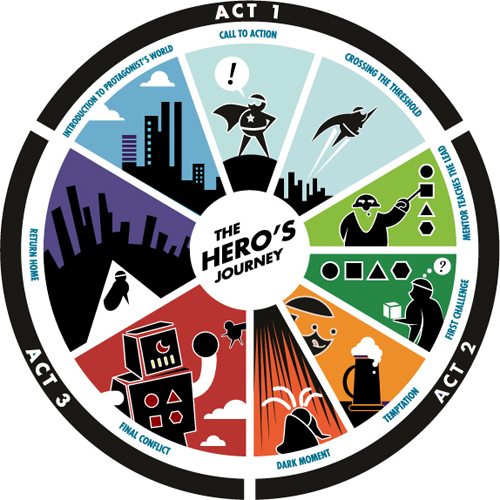
In addition, each of the elements is interestingly structured inside. For example, the first step is the urge to action. It must contain characters, drama, conflict and set the setting. How to show all this in one scene? We open the book and watch - in this scene the hero must be in his everyday world, then an unexpected urge to travel, abandon this urge in favor of the familiar world and an unexpected twist - the incontestable power intrudes into the life of the hero and he already runs into the journey.
That is, Vasya is sitting at home, watching football, the team is winning the world championship, near beer and beautiful wife, the world is beautiful.
Dzzin doorbell. On the threshold is an old man - Vasya, we have been looking for you for a thousand years you have been elected, come with me to the magical country where everything is possible - for the garages!
Vasya silently closes the door and returns to football.
And then he notices that his wife is missing!
And our Vasya is already running for the garages to meet adventures.
The plot does not remind anything? Lord of the Rings? Star Wars? In fact, this is the beginning of any story - about this and the monomith. Remember the key battle with the main villain - he should always almost win and our hero has definitely lost, but here is a trick and an unexpected victory. In a word, a universal thing - you want to come up with something, take a monomith and paint it in your colors.
A separate joke is the analysis of films on fairy tales. Googling how Fight Club was done on the basis of the red cap, a couple of minutes of healthy laughter are provided to you.
3. Psychophysiology of Krol and Whirls

And now go down to the basement. Have you ever wondered how physically the human thought process is arranged? How do electric signals give rise to such a complex consciousness? If you tried to read Soviet textbooks on brain physiology, then you will understand my pain. I have been looking for a book about this for 15 years, and finally it was published in 2017. The main feature is that the authors managed to seriously shrink the amount of text by explaining all the effects through famous works of art and using the human Russian language.
Actually the first third of the book examines the human visual cortex, and clearly shows how a person sees and recognizes images. From the fall of the photon on the retina, the pattern recognition in the frontal lobes. The result of this chapter is the deduction of a simple rule in which art differs from non-art. Why is one picture - a masterpiece, and almost the same - daub. How do art critics define? It turns out art is different using features of the human visual perception system. Similarly, with a mono-minif - every person has a hardware system of vision and you need to write software suitable for this particular hardware.
For example, you have a camera on your phone, you can turn on the frame grid in the options, but do you know why? This is a grid for frame composition according to the “rule of thirds”. A person’s vision is such that his attention is riveted not at all to the center of the frame, but at the four intersections of this grid - place the object in them, and try to align the horizon and other objects on the grid and the result will instantly surprise you - your photos will be at least 4.

And the rule of the third is not the only one, there are a number of other harmonies - I personally like Fibonacci.
Look at what kind of beauty you can turn even a fight in the Ukrainian parliament with the help of science!

But most of all I was struck in the book by the history of the creation of Pointillism. Young artists in Paris in 1885 wrote out journals, among which was “Questions of Psychophysiology” in which there was a specific article on the study of the retina of the eye, in which it was proved that a person sees everything only in dots of three colors. Artists without hesitation tried to draw colored dots. After the first exhibition, they were waited for by world success, a new genre of painting was born. And they just followed the instructions.
Two hundred years have passed and finally a book has been published that fully describes the entire visual system. It will not only give you an understanding of how the brain works, how you see the world and why this happens, but also imperceptibly forces you to complete a full course in art history. And especially through the hardware side of the issue - most of the book is the analysis of the logic of neural networks and their topology in the brain. With the operation of these networks in millisecond. Here is one of the tables, shows how a person sees an ordinary nut in milliseconds:

What types of paintings were born from this table determine for yourself.
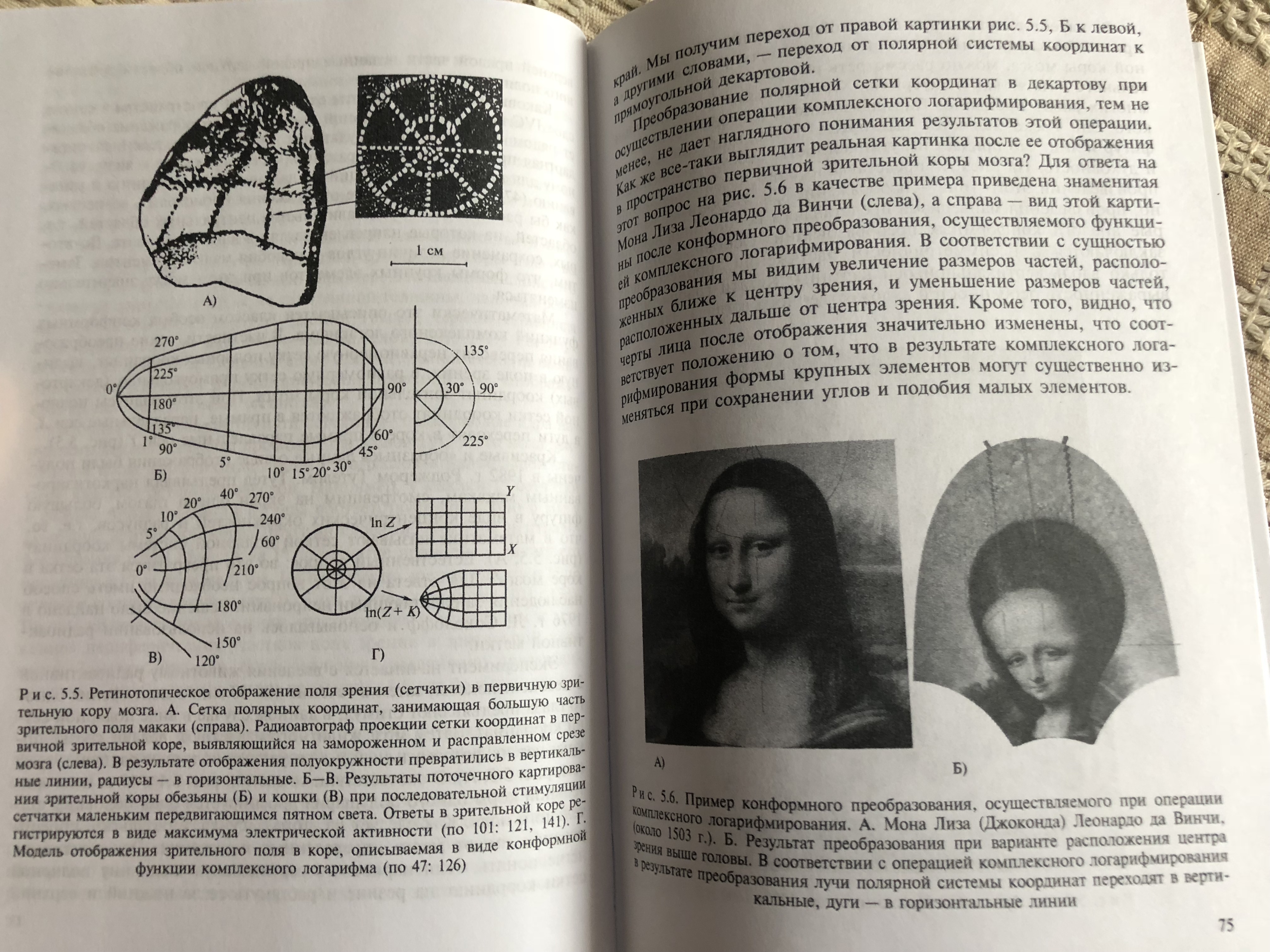
Or here's a treat, a description of the mathematics used by the brain to scan a round image with eyes in a 16: 9 rectangle. Yes, the format of our screens turns out to be the format of our imagination. And if you are familiar with the MPEG technology, then you will be delighted with the chapter, as this compression format was invented on the basis of the same in your brain - all visual information is very cleverly and efficiently compressed using the so-called. "Lateral inhibition".
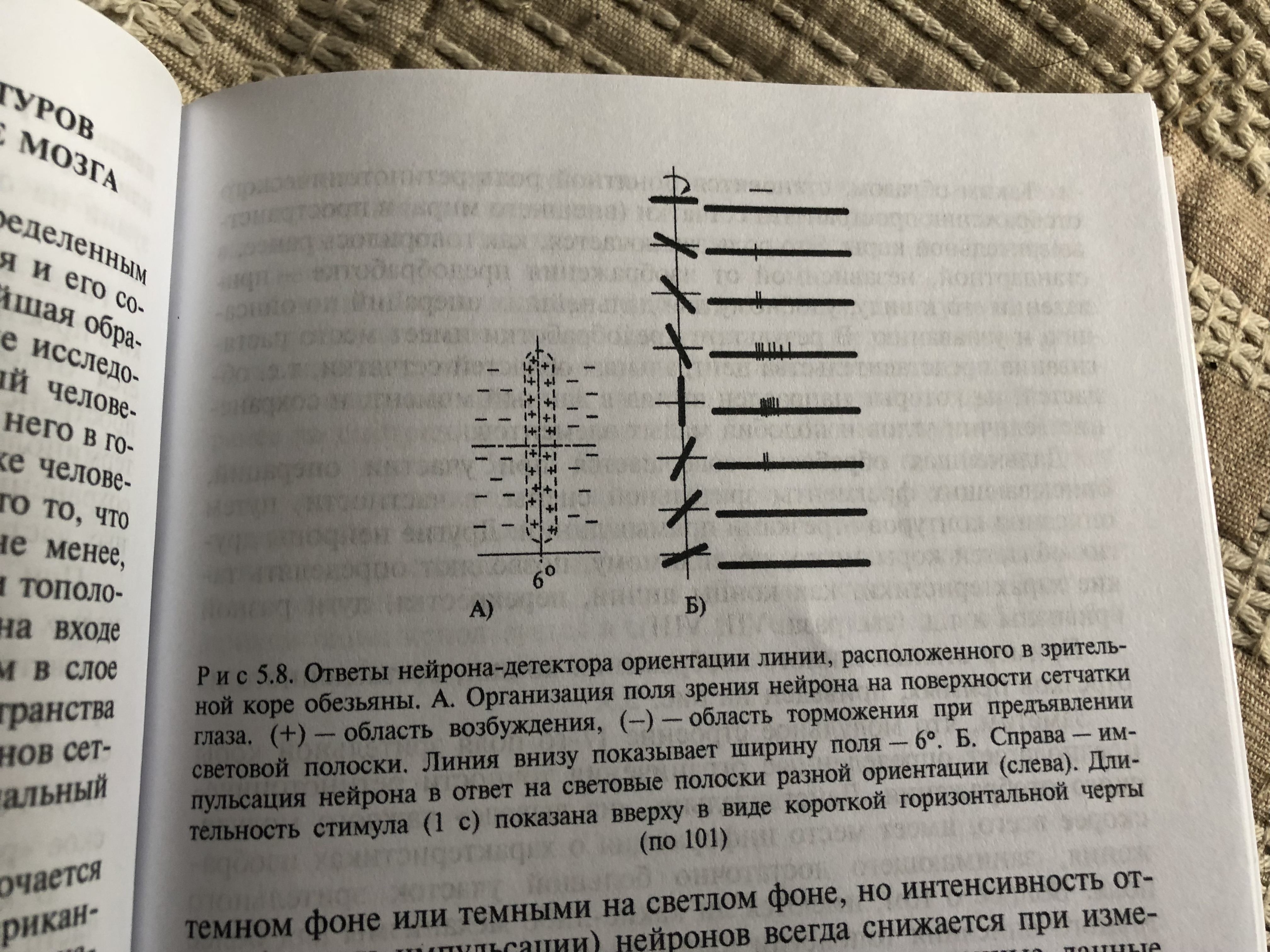
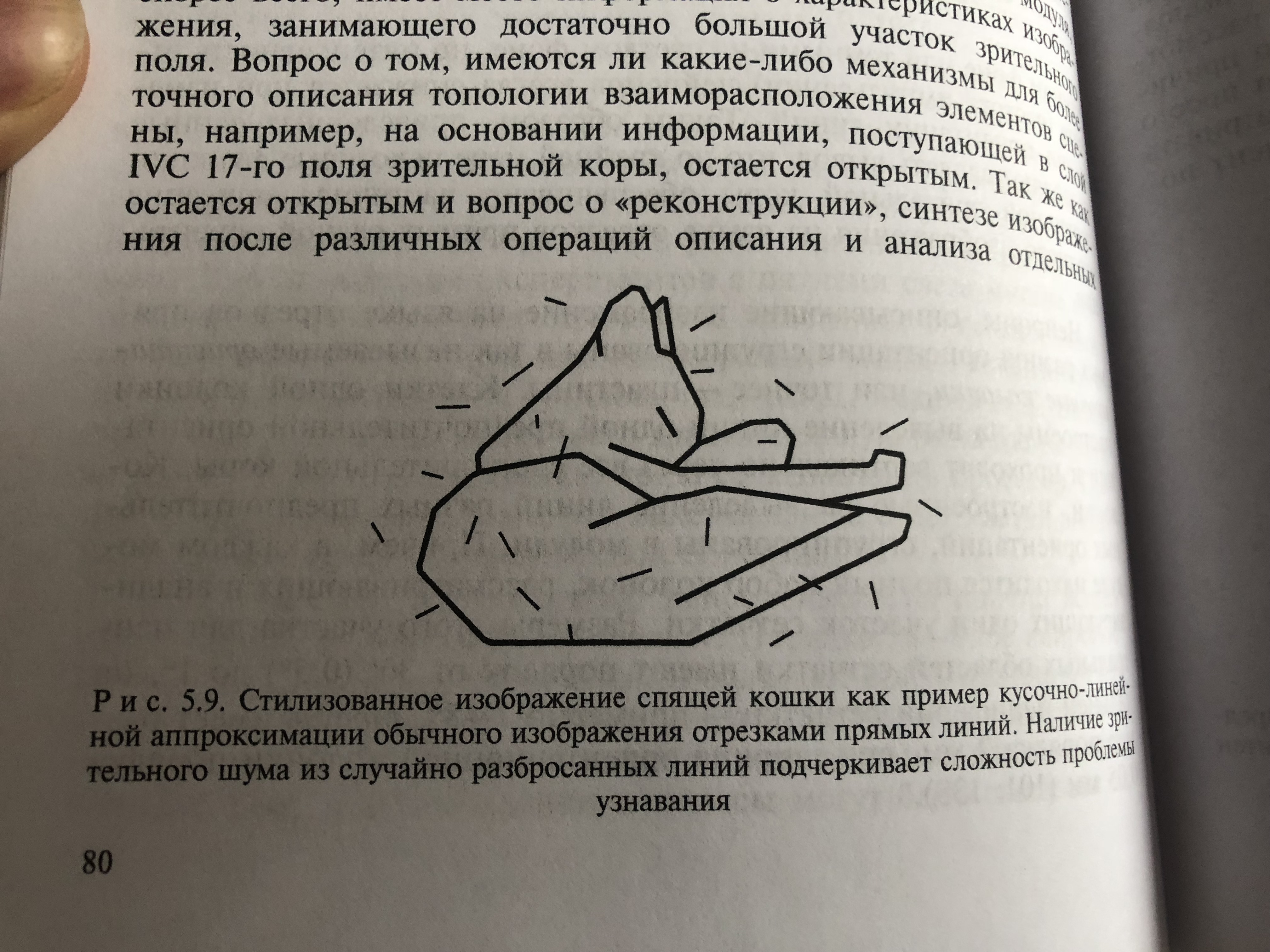
But the most practical knowledge. The visual cortex divides the entire picture into segments of strictly defined degrees of inclination. That is why all comics and advertisements have a clear contour drawing - in this case, the brain does not need to spend efforts on image processing, it is already ready. In the second photo you can see the “perfect cat” - your brain is especially pleased with this style - use this when preparing visual information.
But the coolest thing is of course in the third part of the book, it is called so - the physiology of love and friendship. Probably I will not tell you what they are writing, but I understood about love and friendship from this book more than from all the books on psychology and dramaturgy combined. One analysis of marriage dances of Sterkhov is worth all of Freud, IMHO of course, but still I hope you are intrigued enough to buy the book. IMHO if this book was translated into English - Mackey would definitely make it his desktop guidance.
I note only that the circulation of the book is minimal and it has already become a bibliographic rarity, it remains only to hope that the authors will read this text and decide on a reprint of the circulation.
All Articles